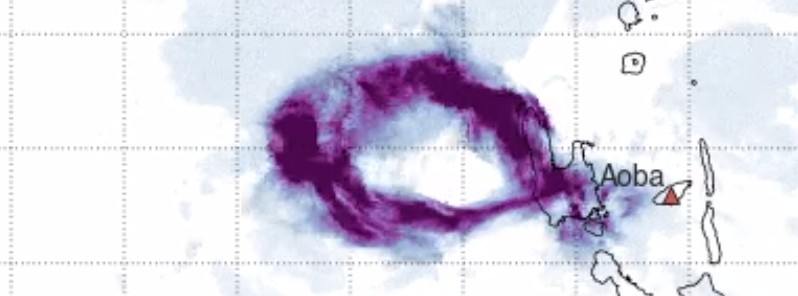Significant eruption at Ambae volcano, more sulfur released than in any eruption over the past 3 years

Ambae volcano remains at the Alert Level 3 with sustained volcanic ashes/gases and villages from east to southeast of Ambae island can continue expecting ash fall and gases. Acid rain may occur during rainfall, Vanuatu Meteorology and Geohazards Department (VMGD) said April 11, 2018, urging people to avoid creeks and streams.
Although Vanuatu's Ambae volcano, also known as Manaro Voui and Aoba, made international headlines in 2017 after more than 13 000 people living around it had to be evacuated, experts are now bringing our attention to April 5, 2018 eruption which was 'missed by the media, and pretty much everyone' because it took place at night.
As reported by volcanologist Erik Klemetti, Ambae volcano has become more restless again starting mid-March 2018 and VMGD noted that these new eruptions mark a change in character for the volcano to more ash-rich, explosive eruptions versus the types that occurred in the fall of 2017.
"Ash from eruptions have fallen on residential and agricultural regions of the small island, contaminating water and potentially becoming a real hazard for the people living on the island again," Klemetti writes.
"This makes ash a larger hazard for air travel or water supplies, but also opens the possibilities of volcanic mudflows (lahars) related to ash deposits and heavy rains," he explains, adding that although the eruptions since mid-March haven’t made the news like the ones in the fall, they might be even more significant.
Klemetti pointed out to a tweet posted by Dr. Simon Carn, an Associate Professor at the Department of Geological and Mining Engineering and Sciences Michigan Technological University, that said the eruption on April 5 may have emitted the most sulfur dioxide of any eruption since the 2015 eruption at Calbuco in Chile.
Major SO2-rich #eruption from #Ambae (#Aoba) #volcano, #Vanuatu at 14:00 UTC on April 5. Looks upper tropospheric; perhaps higher. Est. SO2 loading of ~0.1-0.15 Tg is highest emission recorded from #Ambae and highest globally since Calbuco (#Chile) in Apr 2015. @GeohazardsObs pic.twitter.com/lxYq5QCo6Y
— Simon Carn (@simoncarn) April 6, 2018
Big (preliminary estimates ~0.05–0.07 Tg) SO2 #eruption from #Aoba (#Ambae) in #Vanuatu over night (5 April 14:00 UTC). #Himawari data shows the SO2-rich cloud heading towards #Australia pic.twitter.com/P8t0JXeOOx
— Andy Prata (@andyprata) April 6, 2018
By April 8, the sulfur dioxide plume from the eruption reached from near the eastern coast of Australia to Tahiti.
Change in wind direction caused by the tropical low that was located east of Maewo island over the last few days caused heavy ash fall from Ambae volcano on Maewo on April 8 – 10, 2018. The winds blowing from west to southwest caused the ash fall in nearly all the islands of the north.
On Maewo, the heavy ash fall was even experienced at Naviso on the eastern side of the island. This meant that the winds carried the ash nearly 6 km (3.7 miles) over the steep hills on the central part and on to the eastern side of the island, The Vanuatu Daily Post reported.
In VMGD's volcano alert bulletin issued April 4, the agency said that the volcanic eruption at Ambae confined inside the Lake Voui is stable at Alert Level 3. The restricted area of risk is limited to the area of 3 km (1.86 miles) from the active vent and areas located in the Yellow Zone.
.jpg)
Image credit: Vanuatu Meteorology and Geohazards Department
Ambae volcano remains at the Alert Level 3 with sustained volcanic ashes/gases, VMGD said April 11. Villages from East to South East of Ambae island can continue expecting ash falls and gasses from the volcano. In addition, acid rain may occur during rainfall, the agency said, urging residents to avoid creeks and streams.
Ambae volcano is a very large volcano and is frequently active. In the recorded history, there have been many eruptions, every 10-50 years over the past 150 years. All have been from the summit craters, except one recorded in 1670’s when a lava flow occurred in the Ndui Ndui area. The current eruption is focused in the summit crater and there are no indications of activity elsewhere on Ambae Island.
Featured image credit: Andy Prata

Commenting rules and guidelines
We value the thoughts and opinions of our readers and welcome healthy discussions on our website. In order to maintain a respectful and positive community, we ask that all commenters follow these rules.